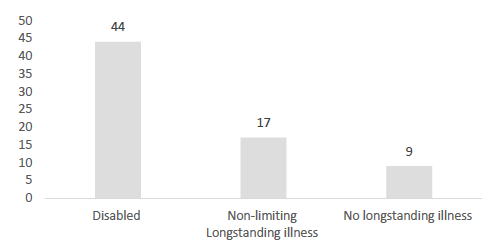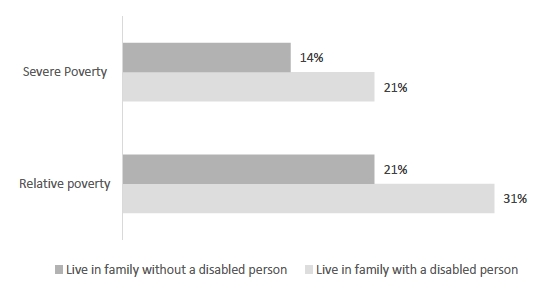Scotland's Wellbeing: national outcomes for disabled people
Analysis of the National Performance Framework (NPF) outcome indicators from the perspective of disability.
2. Children And Young People
We grow up loved, safe and respected so that we realise our full potential
What we know in relation to Children and Young People
- Households containing a disabled person have higher levels of child material deprivation (20%) compared to households with no disabled people (8%).
- Compared to non-disabled children, disabled children more frequently had high scores of difficulties, as measured in the Strengths and Difficulties questionnaire in the Scottish Health Survey.
- Overall, only 53% of young people felt that their perspectives were taken into account by adults. Less disabled young adults felt their perspectives were considered (47%) than non-disabled young adults (58%).
- Disabled children reported more social, emotional and behavioural difficulties at an early age, compared to non-disabled children.
- The majority of disabled children (75%) said they had three or more friends, although this was slightly lower than for non-disabled children (82%).
- Childcare satisfaction for parents with disabled children is comparable to that of parents with non-disabled children, although the data suggests some gaps in provision.
National outcome
This outcome focuses on children and young people and sets out a direction to provide the essential conditions of love, respect and understanding through which children can become the happy, fulfilled and successful adults they have a right to be.
The vision for this outcome contains a number of different aspects including a childhood free from abuse, tobacco, alcohol, drugs, poverty and hunger where children are connected into society and involved in decisions about their lives. It also aims to provide safe places in which all children can be stimulated, healthy and active. Finally, it aims for early education where everyone can learn, play and flourish.
National Performance Indicators
In total, there are seven indicators for Children and Young people in the National Performance Framework. Two are not appropriate indicators for the purpose of this analysis:
- Healthy start (child mortality rates)
- Quality of children’s services (percentage of funded Early Learning and Childcare providers achieving good or better across all four quality themes).
Healthy Start measures stillbirths and very early mortality among infants. As a result, it is not possible to break this figure down by disability. Quality of children’s services is about how services are rated, so does not measure individuals. However, it is possible to compare outcomes for parents of disabled and non-disabled children using data from an analysis of the GUS survey.
One indicator measures an individual outcome, but can’t currently be broken down by disability status:
- Child social and physical development (i.e. the percentage of eligible children with no concerns at their 27-30 month review).
This data is collected by the Information Services Division of NHS Scotland. Currently, data on whether or not children have long-term conditions/disabilities is collected locally by health boards and is not available at a national level. This situation is under review and national level data is expected by 2021 at the earliest. However, GUS provides more general data on social and physical development of disabled children, which is discussed below.
The remaining four indicators are individual level and broken down by disability status:
- Children Have Positive Relationships (Percentage of S2 and S4 pupils who report to have "three or more" close friends).
- Children’s voice (percentage of young people who feel they have their views taken into account by adults in relation to decisions that affect their lives).
- Child Material Deprivation (Percentage of children in combined material deprivation and low income after housing costs (below 70% of UK median income)).
- Child wellbeing and happiness. A score is calculated by a short-behavioural screening tool that forms part of the SHeS and is completed by the parents of 4-12 year olds. This indicator measures the total number of children whose total difficulties score was rated as abnormal or borderline.
Children have positive relationships
This measure comes from the Scottish Schools and Adolescent Lifestyle and Substance Use Survey (SALSUS). In 2015, compared to non-disabled children, a smaller percentage of disabled children reported having three or more friends. 75% of disabled children reported having three or more friends, while 82% of non-disabled children reported this.
Children’s Voices
This measure comes from the ‘Young People in Scotland’ survey[6]. In 2017, 53% of young people agreed that adults took their views into account when making decisions that affected them. However, less disabled children agreed that adults took their views into account (47% compared to 58% of non-disabled children).
Child Material Deprivation
The rate of material deprivation among children is higher in families with a disabled member. According to data provided by the Family Resources Survey (FRS)[7], between 2015-18, the level of combined low income and material deprivation among children in Scotland was 12%. Among families with a disabled person in the household, the rate was 20%, compared to 8% among those with disabled person in the family.[8]
Child Wellbeing and Happiness
This measure is based on the Strengths and Difficulties Questionnaire (SDQ).
This questionnaire is completed by parents as part of the Scottish Health Survey (SheS). The SDQ comprises 25 questions covering themes such as consideration, hyperactivity, malaise, mood, sociability, obedience, anxiety and unhappiness.
It is used to measure five aspects of children's development: emotional symptoms; conduct problems; hyperactivity/inattention; peer relationship problems; and pro-social behaviour.
Figure 2.1 The proportion of children aged 4-12 who had a borderline or abnormal total difficulties score, for 2013-16, as assessed in the Scottish Health Survey, by disability.

Source: Scottish Health Survey 2017
A higher proportion of disabled children had scores of total difficulties over 14, the cut-off point at which scores are reported as “borderline or abnormal” (see Figure 2.1). Difficulties scored are established by summing the scores from all the domains except pro-social behaviour. The total difficulties score ranged from zero to forty with a higher score indicating greater evidence of difficulties. There are established thresholds indicating ‘normal’ (score of 13 or less), ‘borderline’ (14-16) or ‘abnormal’ scores (17 or above).
Additional Indicators
Child Social and Physical Development
GUS[9] includes a measure of child development. It shows that disabled children were significantly more likely than non-disabled children to have missed key development milestones associated with gross or fine motor skills at 10 months and age three.[10] However, once socio-economic factors were taken into account disability did not, by itself, predict these differences.
Disabled children also tended to have higher levels of social, emotional and behavioural difficulties at ages four and five. This relationship remained after controlling for socio-economic characteristics. The strength of this relationship increased for children with a limiting disability (as GUS statistics count both non-limiting and limiting as ‘disabled’).
Quality of Children’s Services
Evidence from GUS indicates that:
- There was no significant difference in the use of regular childcare between parents of disabled and non-disabled children. Disabled children were, however, slightly less likely to have attended pre-school (89% compared with 93%).
- Parents did not differ in the amount of choice they felt they had when choosing childcare (at ages two and five). However, at age three a higher proportion of parents with disabled children than those with non-disabled children felt they had no choice at all.
- In addition, parents with disabled children were more likely to say that they had found it fairly or very difficult to arrange childcare (though most had not found it difficult).
- Parents of disabled children were less likely than parents of non-disabled children to be 'very satisfied' with their main childcare provider when the child was under five. However, at ages five and six there were no differences in satisfaction.
- Parents of disabled children were more likely to say that they were not using childcare because their child needed special care. The proportion (of those not using childcare) expressing this view decreased from 7% at 10 months to 4% at age 5.
- Disability and limiting disability were not independently associated with any of the childcare or pre-school indicators of satisfaction or availability.
Children’s Social Relationships - Bullying
There is evidence from the UK more broadly which suggests that disabled children may be at a greater risk of bullying than non-disabled children. For example, research based on longitudinal data from England was published by Institute of Education in 2014. This found that disabled children in England, at ages seven and 15, were at a higher risk of bullying than non-disabled children even after a wide range of factors were controlled for.[11]
Poverty and Low Income
In this data, relative poverty means that household earnings are less than 60% of the UK median after household size and housing costs have been accounted for. Severe poverty refers to earnings of less than 50% than the UK median, after housing costs. Children in families with a disabled member are more likely to be in both relative and severe poverty after housing costs, compared to children in families without a disabled member.
Data from the FRS[12] show that, between 2015/16 and 2017/18, 31% of children with a disabled person in the household were in relative poverty after housing costs. For families without a disabled member, the comparative figure was 21%. For severe poverty after housing costs, 21% of children in families with a disabled member were in this situation, compared to 14% of children in families without a disabled member (see Figure 2.2).
Figure 2.2 Percentage of children living in severe and relative poverty after housing costs, by whether family has a disabled member or not, for the period 2015-18.

Source: Poverty and Income Inequality in Scotland: 2015-2018
There is some variation in outcomes based on which family member is disabled. For households where the disabled family member is a child, 26% of children live in relative poverty after housing costs, compared to 24% of children in families without a disabled child. When the disabled member is an adult, the number of children in relative poverty after housing costs rises to 32%, compared to 22% for families without a disabled adult.
Contact
Email: joseph.ritchie@gov.scot
There is a problem
Thanks for your feedback